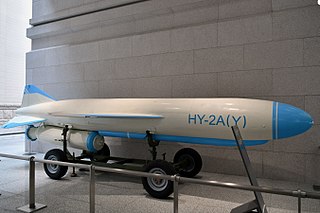Related Research Articles

The Shang You or SY-series, and the Hai Ying or HY-series were early Chinese anti-ship cruise missiles. They were derived from the Soviet P-15 Termit missile.

The Lockheed D-21 is an American supersonic reconnaissance drone. The D-21 was initially designed to be launched from the back of an M-21 carrier aircraft, a variant of the Lockheed A-12 aircraft. The drone had maximum speed in excess of Mach 3.3 at an operational altitude of 90,000 feet. Development began in October 1962. Originally known by the Lockheed designation Q-12, the drone was intended for reconnaissance deep into enemy airspace.

The Lockheed X-7 was an American unmanned test bed of the 1950s for ramjet engines and missile guidance technology. It was the basis for the later Lockheed AQM-60 Kingfisher, a system used to test American air defenses against nuclear missile attack.

The Burya was a supersonic, intercontinental cruise missile, developed by the Lavochkin design bureau under designation La-350 from 1954 until the program cancellation in February 1960. The request for proposal issued by the Soviet government in 1954, called for a cruise missile capable of delivering a nuclear payload to the United States. Analogous developments in the United States were the SM-62 Snark and SM-64 Navaho cruise missiles, particularly the latter, which used parallel technology and had similar performance goals.

The Lavochkin La-17 was the first Soviet unmanned aerial vehicle (UAV) to reach operational service. The first versions were developed in the early 1950s, and remained in service into the 1980s.

The C-301 is a large supersonic coastal defense anti-ship missile (AShM), and it is the basis on which two other members of the C-300 series AShM C-302 and C-303 developed from.

The MQM-42 was a supersonic target drone developed by North American Aviation. Developed in two subvariants, Redhead and Roadrunner, it was used by the United States Army in the 1960s and 1970s.
AVIC UAVs are Chinese UAVs developed by Aviation Industry Corporation of China (AVIC), some of which has entered service with Chinese military.
Sunward UAVs are Chinese UAVs developed by Hunan Sunward Co Ltd,, a firm formed in February 2008 by a professor of Tsinghua University as a subsidiary of Sunward Intelligent Equipment Group to concentrate on aviation products. Sunward that not only produces UAVs of its own design, but also produce light sport aircraft such as the two-seater Sunward Aurora SA60L and flying boat Ramphos Trident for other firms as their original equipment manufacturer.
Sky Hawk UAV is a series of Chinese UAVs developed by China Aerospace Science and Industry Corporation (CASIC), some of which is marketed by ADIC Technology Pte of Singapore.
BMP UAVs are Chinese UAVs developed by Beijing MicroPilot Unmanned Aerial Vehicle Flight Control System Ltd. , a company originally formed in 2001 specifically handle the import business of autopilots produced by Canadian firm MicroPilot for UAVs. Over the decade, the company expanded its business to importing other flight control systems to China, such as those produced by Russia. In recent years, in addition to being a supplier of subsystems to other Chinese UAV manufacturers, BMP further expanded its business to developing its own brand of UAVs by integrating autopilots and flight control systems to existing airframes, but there are some BMP UAV are designed by BMP itself. As an original equipment manufacturer, BMP is also contractor to produce UAVs developed by other Chinese establishments such as universities, research institutes and other Chinese UAV manufacturers.
Quanhua UAVs are Chinese UAVs developed by Tianjin Quan-Hua Times Spaceflight Technology Co., Ltd. , some of which has entered service with Chinese military and law enforcement establishments.
CASC Rainbow is a series of unmanned aerial vehicles (UAVs) developed by the China Academy of Aerospace Aerodynamics, an entity under the China Aerospace Science and Technology Corporation (CASC). The China Academy of Aerospace Aerodynamics is also known as the 11th Academy of CASC, or 701st Research Institute.
HLKX UAVs are Chinese UAVs developed by Guilin Hanglong Kexun Electronics Technology Co., Ltd. , some of which have entered service with Chinese military, paramilitary, law enforcement and governmental agencies.
The ASN UAV are a series of Chinese UAVs developed by Xi'an Aisheng Technology Group Co., Ltd (西安爱生技术集团公司)ASN Technology Group Co., Ltd (西安爱生技术集团公司), also known as Northwestern Polytechnical University UAV Research Institute or 365th Institute, established in 1984.
The Nord CT.41 Narwhal was a French target drone, designed and built by Nord Aviation during the late 1950s for the purpose of providing training in the interception of supersonic bomber aircraft.
BUAA unmanned helicopters are Chinese UAVs developed by Beihang University (BUAA), some of which have entered service with the Chinese military and government establishments.
NRIST UAVs are Chinese UAVs developed by Nanjing Research Institute of Simulation Technology (南京模拟技术研究所) (NRIST), also known as the 60th Research Institute of People's Liberation Army General Staff Department (总参六十所), an ISO 9001 certified research/production facility headquartered in Nanjing.
The SYAC UAV are a type of Chinese UAVs developed by Shenyang Aircraft Corporation (SYAC), some of which have entered service with Chinese military and local law enforcement and governmental establishments.

The Wind Shadow and Cloud Shadow, also known as Wing Loong-10, is a series of unmanned aerial vehicles of the High-Altitude Long Endurance (HALE) type, featuring a stealthy air-frame. As of 2017 it is being developed by the Chengdu Aircraft Industry Group for reconnaissance and precision strike missions.
References
- ↑ "Booby UAV". Archived from the original on 2014-05-15. Retrieved 2014-05-14.
- ↑ Long Eagle
- ↑ Long Eagle
- ↑ Long Eagle
- ↑ "Drone-6". Archived from the original on 2014-04-04. Retrieved 2014-05-14.
- ↑ M-21 Unmanned aerial vehicle
- ↑ "M-21 UAV". Archived from the original on 2014-05-14. Retrieved 2014-05-14.
- ↑ "M-21". Archived from the original on 2013-12-03. Retrieved 2014-05-14.
- ↑ Zhao Lei (2018-05-31). "Biggest civilian drone designed for couriers". China Daily .